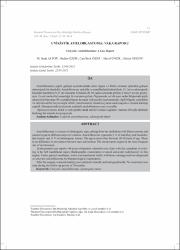| dc.contributor.author | Altop, Müzeyyen Seda | |
| dc.contributor.author | Özer, Nedim | |
| dc.contributor.author | Özer, Can Berk | |
| dc.contributor.author | Ünür, Meral | |
| dc.contributor.author | Yegen, Gülçin | |
| dc.date.accessioned | 2020-07-03T11:39:46Z | |
| dc.date.available | 2020-07-03T11:39:46Z | |
| dc.date.issued | 2014 | en_US |
| dc.identifier.citation | Altop, M. S., Özer, N., Özer, C. B., Ünür, M. ve Yegen, G. (2014). Unikistik ameloblastoma: Vaka raporu. İstanbul Üniversitesi Diş Hekimliği Fakültesi Dergisi, 48(2), 51-56. | en_US |
| dc.identifier.issn | 2149-2352 | |
| dc.identifier.uri | https://hdl.handle.net/20.500.12511/5387 | |
| dc.description.abstract | Ameloblastoma çeşitli gelişim aşamalarındaki mine organı ve fibröz stromalı epitelden gelişen odontojenik bir tümördür. Ameloblastoma maksilla ve mandibuladaki tümörlerin %1'ini ve odontojenik kaynaklı tümörlerin %11'ini oluşturur. Ortalama 20-50 yaşları arasında görülür. Cinsiyet ayrımı göstermez. En sık molar diş komşuluğu ile ramustan gelişir. Olgumuzda, sol alt çene molar bölgesinde şişlik şikayetiyle başvuran 48 yaşındaki bayan hastanın radyografik incelemesinde, ilgili bölgede uniloküler ve radyolusent bir lezyon tespit edildi. Genel anestezi altında lezyonun enükleasyonu ve kemik küretajı yapıldı. Histopatolojik incelemede unikistik ameloblastoma tanısı konuldu. Operasyon sonrası klinik ve radyografik olarak tam bir iyileşme sağlandı. Hastanın 20 aylık takibinde herhangi bir tekrarla karşılaşılmadı. | en_US |
| dc.description.abstract | Ameloblastoma is a tumor of odontogenic type, arising from the epithelium with fibrous stroma and enamel organ in different steps of evolution. Ameloblastoma represents 1 % of maxillary and mandibulary tumors and 11 % of odontogenic tumors. The age is most often between 20-50 years of age. There is no difference in prevalance between men and women. The molar-ramus region is the most frequent site of involvement. In the present case report a 48-years-old patient referred to our clinic with the complaint of swelling in her left mandibular region. Radiographic examination revealed uniloculer radiolucency in this region. Under general anesthesia, lesion was enucleated totally with bone curretage and was diagnosed as unicystic ameloblastoma by histopatological examination.After the surgery, complete healing was optained clinically and radiographically. No recurrence was seen during the follow up period of 20 months. | en_US |
| dc.language.iso | tur | en_US |
| dc.publisher | İstanbul Üniversitesi | en_US |
| dc.rights | info:eu-repo/semantics/openAccess | en_US |
| dc.subject | Unikistik Ameloblastoma | en_US |
| dc.subject | Odontojenik Tümör | en_US |
| dc.subject | Unicystic Ameloblastoma | en_US |
| dc.subject | Odontogenic Tumor | en_US |
| dc.title | Unikistik ameloblastoma: Vaka raporu | en_US |
| dc.title.alternative | Unicystic ameloblastoma: A case report | en_US |
| dc.type | article | en_US |
| dc.relation.ispartof | İstanbul Üniversitesi Diş Hekimliği Fakültesi Dergisi | en_US |
| dc.department | İstanbul Medipol Üniversitesi, Diş Hekimliği Fakültesi, Ağız, Diş ve Çene Cerrahisi Ana Bilim Dalı | en_US |
| dc.identifier.volume | 48 | en_US |
| dc.identifier.issue | 2 | en_US |
| dc.identifier.startpage | 51 | en_US |
| dc.identifier.endpage | 56 | en_US |
| dc.relation.publicationcategory | Makale - Uluslararası Hakemli Dergi - Kurum Öğretim Elemanı | en_US |


















